Edelstein-Keshet L. Mathematical Models in Biology
Подождите немного. Документ загружается.

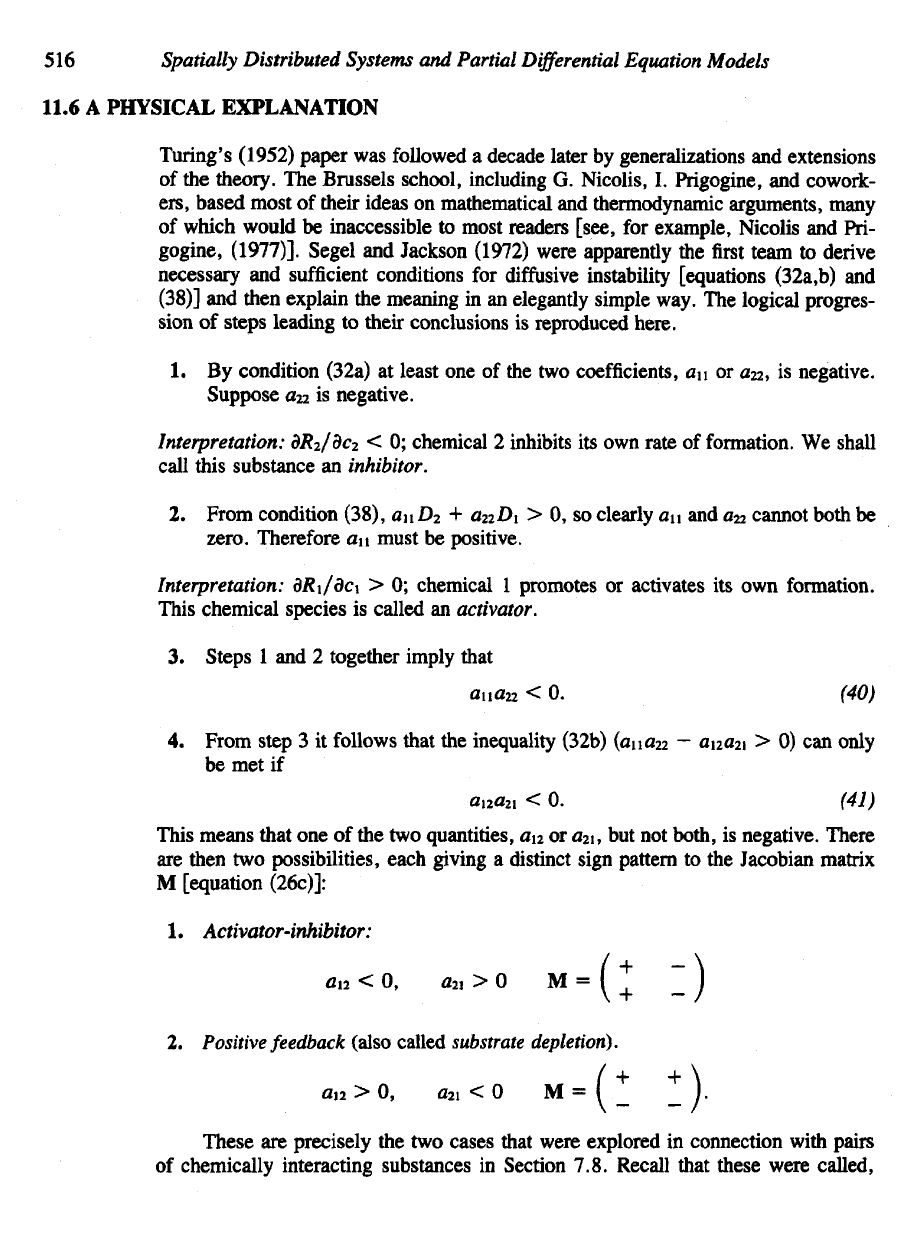
516
Spatially
Distributed
Systems
and
Partial
Differential
Equation
Models
11.6
A
PHYSICAL EXPLANATION
Turing's (1952) paper
was
followed
a
decade later
by
generalizations
and
extensions
of
the
theory.
The
Brussels school, including
G.
Nicolis,
I.
Prigogine,
and
cowork-
ers,
based
most
of
their
ideas
on
mathematical
and
thermodynamic arguments, many
of
which would
be
inaccessible
to
most readers [see,
for
example, Nicolis
and
Pri-
gogine,
(1977)].
Segel
and
Jackson (1972) were apparently
the first
team
to
derive
necessary
and
sufficient
conditions
for
diffusive
instability [equations (32a,b)
and
(38)]
and
then explain
the
meaning
in an
elegantly simple way.
The
logical progres-
sion
of
steps
leading
to
their conclusions
is
reproduced here.
1. By
condition (32a)
at
least
one of the two
coefficients,
a\\ or
a
22
,
is
negative.
Suppose
022
is
negative.
Interpretation:
dR
2
/dc
2
< 0;
chemical
2
inhibits
its own
rate
of
formation.
We
shall
call
mis
substance
an
inhibitor.
2.
From condition (38),
an D
2
+
a
22
D\
> 0, so
clearly
an an
22
annot both
be
zero. Therefore
a\\
must
be
positive.
Interpretation:
dR\/dc\
> 0;
chemical
1
promotes
or
activates
its own
formation.
This chemical species
is
called
an
activator.
3.
Steps
1 and 2
together imply that
4.
From step
3 it
follows that
the
inequality (32b)
(a\\a?i
—
a\
2
a
2
\
> 0) can
only
be met if
This
means that
one of the two
quantities,
a\
2
or
a
21
,
but not
both,
is
negative. There
are
then
two
possibilities,
each giving
a
distinct sign pattern
to the
Jacobian matrix
M
[equation
(26c)]:
1.
Activator-inhibitor:
2.
Positive
feedback
(also called
substrate
depletion).
These
are
precisely
the two
cases
that
were explored
in
connection
with
pairs
of
chemically interacting substances
in
Section 7.8. Recall that these were called,
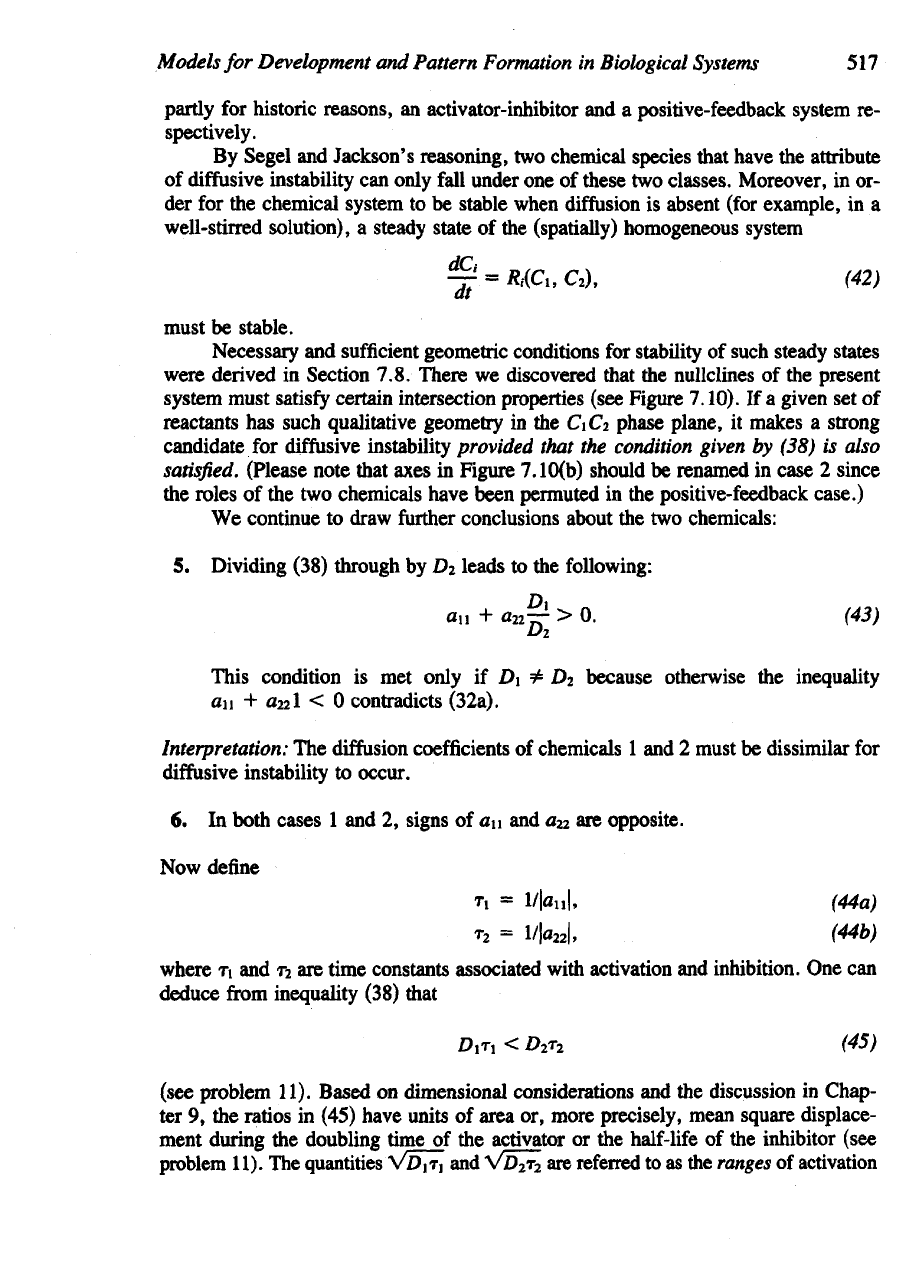
Models
for
Development
and
Pattern
Formation
in
Biological
Systems
517
partly
for
historic reasons,
an
activator-inhibitor
and a
positive-feedback system
re-
spectively.
By
Segel
and
Jackson's reasoning,
two
chemical species that have
the
attribute
of
diffusive
instability
can
only
fall
under
one of
these
two
classes. Moreover,
in or-
der for the
chemical system
to be
stable
when
diffusion
is
absent (for example,
in a
well-stirred solution),
a
steady state
of the
(spatially) homogeneous system
must
be
stable.
Necessary
and
sufficient
geometric conditions
for
stability
of
such steady states
were derived
in
Section
7.8. There
we
discovered that
the
nullclines
of the
present
system must satisfy certain intersection properties (see Figure
7.10).
If a
given
set of
reactants
has
such qualitative geometry
in the dC
2
phase plane,
it
makes
a
strong
candidate
for
diffusive
instability
provided
that
the
condition
given
by
(38)
is
also
satisfied.
(Please
note that axes
in
Figure 7.10(b) should
be
renamed
in
case
2
since
the
roles
of the two
chemicals have been permuted
in the
positive-feedback case.)
We
continue
to
draw
further
conclusions about
the two
chemicals:
5.
Dividing (38) through
by
£>
2
leads
to the
following:
This condition
is met
only
if D\
=£
D
2
because otherwise
the
inequality
an
+
022!
< 0
contradicts (32a).
Interpretation:
The
diffusion
coefficients
of
chemicals
1 and 2
must
be
dissimilar
for
diffusive
instability
to
occur.
6. In
both cases
1 and 2,
signs
of a\\ and a
22
are
opposite.
Now
define
where
T\ and r
2
are
time constants
associated
with activation
and
inhibition.
One can
deduce
from
inequality (38) that
(see problem 11). Based
on
dimensional considerations
and the
discussion
in
Chap-
ter 9, the
ratios
in
(45) have units
of
area
or,
more precisely, mean square
displace-
ment
during
the
doubling time
of the
activator
or the
half-life
of the
inhibitor (see
problem
11).
The
quantities
VD^ and
VD
2
T
2
are
referred
to as the
ranges
of
activation
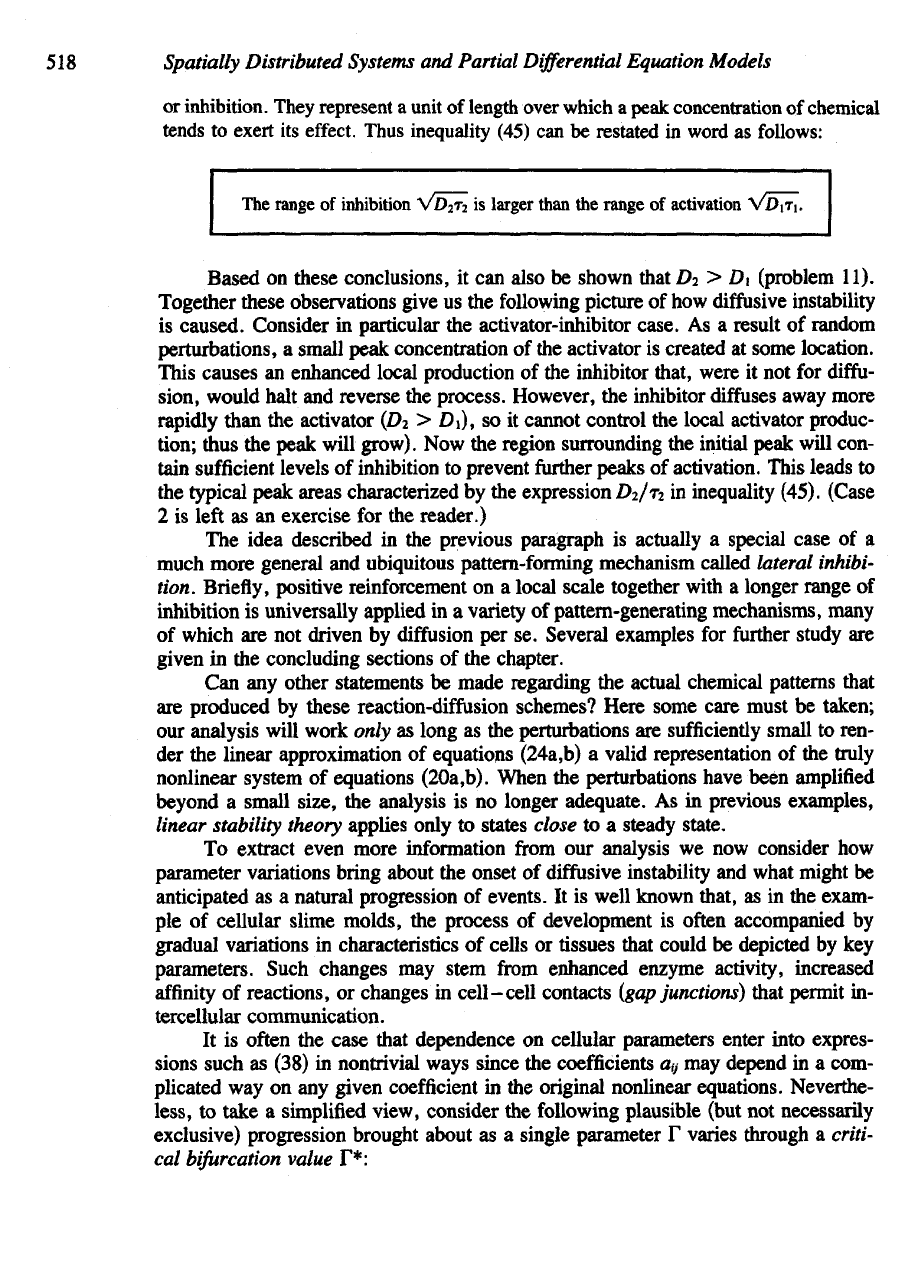
518
Spatially
Distributed
Systems
and
Partial
Differential
Equation
Models
or
inhibition.
They
represent
a
unit
of
length
over which
a
peak concentration
of
chemical
tends
to
exert
its
effect.
Thus
inequality
(45)
can be
restated
in
word
as
follows:
The
range
of
inhibition
is
larger
than
the
range
of
activation
Based
on
these conclusions,
it can
also
be
shown
that
D
2
> D\
(problem
11).
Together these observations give
us the
following picture
of how
diffusive
instability
is
caused.
Consider
in
particular
the
activator-inhibitor
case.
As a
result
of
random
perturbations,
a
small peak concentration
of the
activator
is
created
at
some location.
This
causes
an
enhanced local production
of the
inhibitor that, were
it not for
diffu-
sion, would halt
and
reverse
the
process.
However,
the
inhibitor
diffuses
away more
rapidly than
the
activator
(D
2
>
I>i),
so it
cannot control
the
local activator produc-
tion; thus
the
peak will grow).
Now the
region surrounding
the
initial peak will con-
tain
sufficient
levels
of
inhibition
to
prevent
further
peaks
of
activation. This leads
to
the
typical peak areas characterized
by the
expression
D
2
/T
2
in
inequality
(45).
(Case
2 is
left
as an
exercise
for the
reader.)
The
idea described
in the
previous paragraph
is
actually
a
special case
of a
much
more general
and
ubiquitous pattern-forming mechanism called
lateral
inhibi-
tion. Briefly, positive reinforcement
on a
local scale together with
a
longer range
of
inhibition
is
universally applied
in a
variety
of
pattern-generating mechanisms, many
of
which
are not
driven
by
diffusion
per se.
Several examples
for
further
study
are
given
in the
concluding sections
of the
chapter.
Can any
other statements
be
made regarding
the
actual chemical patterns that
are
produced
by
these reaction-diffusion schemes? Here some care must
be
taken;
our
analysis will work
only
as
long
as the
perturbations
are
sufficiently
small
to
ren-
der the
linear approximation
of
equations (24a,b)
a
valid representation
of the
truly
nonlinear system
of
equations (20a,b).
When
the
perturbations have been
amplified
beyond
a
small
size,
the
analysis
is no
longer
adequate.
As in
previous examples,
linear
stability
theory
applies only
to
states close
to a
steady state.
To
extract even more information
from
our
analysis
we now
consider
how
parameter variations bring about
the
onset
of
diffusive
instability
and
what
might
be
anticipated
as a
natural progression
of
events.
It is
well known that,
as in the
exam-
ple of
cellular
slime molds,
the
process
of
development
is
often
accompanied
by
gradual
variations
in
characteristics
of
cells
or
tissues that could
be
depicted
by key
parameters. Such changes
may
stem
from
enhanced enzyme activity, increased
affinity
of
reactions,
or
changes
in
cell-cell
contacts
(gap
junctions)
that permit
in-
tercellular
communication.
It
is
often
the
case
that dependence
on
cellular parameters enter into expres-
sions
such
as
(38)
in
nontrivial ways since
the
coefficients
a
tj
may
depend
in a
com-
plicated
way on any
given coefficient
in the
original nonlinear equations. Neverthe-
less,
to
take
a
simplified view,
consider
the
following plausible (but
not
necessarily
exclusive) progression brought about
as a
single parameter
F
varies through
a
criti-
cal
bifurcation
value
F*:

Models
for
Development
and
Pattern
Formation
in
Biological Systems
519
1. For F < F*,
diffusive
instability
is not
possible.
The
parabola H(q
2
)
is
positive
for all
wavelengths
q. No
perturbations
of any
wavelength
can
lead
to
pattern formation.
2. For T = F*,
//(#Li)
- 0.
This
is the
threshold situation.
Just
beyond
it
lies
the
realm
of
diffusive
instability;
that
is, for
slightly larger values
of T, H is
negative
but
only
for
values
of q
2
very
close
to
q
2
^. Only perturbations whose
wavenumber
is
^mu,
will
be
amplified
and
expressed
in the final
patterns.
3. For F > F*,
H(q
2
)
< 0 for a
whole range
of q
values:
Any
perturbation whose wavenumber falls within this range will
be
amplified.
Situation
2 is
often
called
the
onset
of
diffusive
instability.
At
this critical point
one
would expect patterns with
a
typical spacing between chemical concentration
peaks
d,
where
Summary
of
Two-Species
Chemical
Interactions
Leading
to
Pattern
Formation
Necessary
conditions
1. The
system must have
a
nontrivial spatially
uniform
steady state
S.
2. The
pair must interact
as an
activator-inhibitor
or a
positive feedback system
(in
the
sense that
the
sign pattern
of the
Jacobian
of the
system
at S is the
same
as
one of the
cases
given
in
this section).
3. (a) The
steady state
5
should
be
stable
in the
well-mixed system. This
is
equivalent
to the
following:
(b)
The
configuration
of
nullclines
/?,(d,
C
2
) =
R
2
(Ci,
C
2
) = 0 at
their
nontrivial
intersection should
be of the
type shown
in
Figures 7.10(o
or b).
4. The
rate
of
diffusion
of the
inhibitor
(in
case
1) or of the
substance receiving
negative feedback
(in
case
2)
must
be
larger than that
of the
other activating
sub-
stance.
Necessary
and
sufficient
conditions
5. (a)
Conditions (32a,b)
and
(38)
should
be
satisfied,
or
(b)
All
necessary conditions
1
through
4
hold
and,
in
addition,
This
is
equivalent
to the
statement
that
the
range
of
activation
is
smaller
than
the
range
of
inhibition.
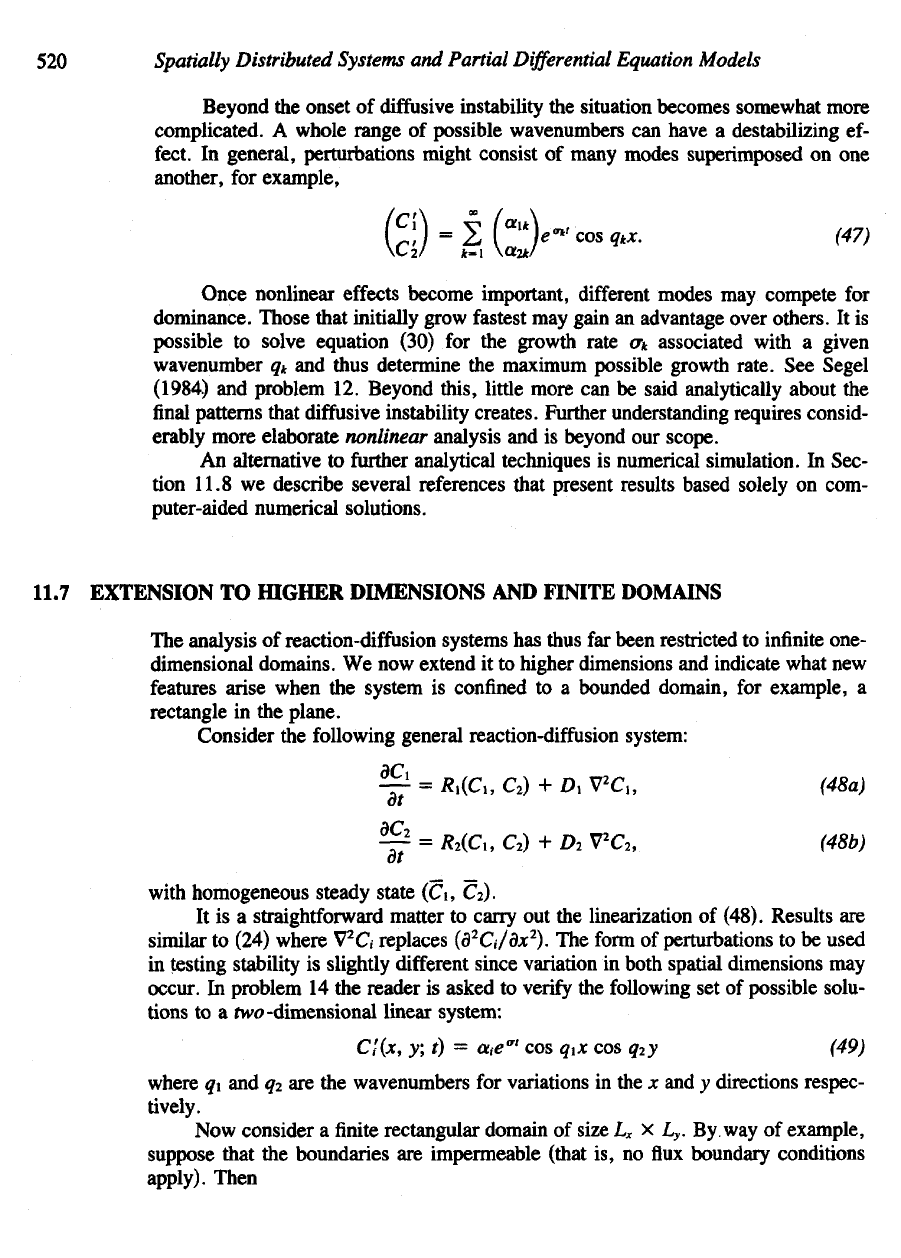
520
Spatially
Distributed
Systems
and
Partial
Differential
Equation
Models
Beyond
the
onset
of
diffusive
instability
the
situation becomes somewhat more
complicated.
A
whole range
of
possible wavenumbers
can
have
a
destabilizing
ef-
fect.
In
general,
perturbations might consist
of
many modes superimposed
on one
another,
for
example,
Once nonlinear effects become important,
different
modes
may
compete
for
dominance. Those that initially grow fastest
may
gain
an
advantage over others.
It is
possible
to
solve
equation (30)
for the
growth rate
er*
associated with
a
given
wavenumber
q
k
and
thus determine
the
maximum possible growth rate.
See
Segel
(1984.)
and
problem
12.
Beyond this,
little
more
can be
said analytically about
the
final
patterns that
diffusive
instability creates. Further understanding requires consid-
erably more elaborate nonlinear analysis
and is
beyond
our
scope.
An
alternative
to
further
analytical techniques
is
numerical simulatio Sec-
tion 11.8
we
describe several references that present results based solely
on
com-
puter-aided numerical solutions.
11.7
EXTENSION
TO
HIGHER DIMENSIO
ND
FINITE DOMAINS
The
analysis
of
reaction-diffusion
sy s
has
thus
far
been restricted
to
infinite
one-
dimensional domains.
We now
extend
it to
higher dimensions
and
indicate what
new
features
arise when
the
system
is
confined
to a
bounded domain,
for
example,
a
rectangle
in the
plane.
Consider
the
following general
reaction-diffusion
system:
with
homogeneous steady state (C\, Cz).
It
is a
straightforward matter
to
carry
out the
linearization
of
(48). Results
are
similar
to
(24) where V
2
C, replaces (d
2
d/dx
2
).
The
form
of
perturbations
to be
used
in
testing stability
is
slightly
different
since variation
in
both spatial dimensions
may
occur.
In
problem
14 the
reader
is
asked
to
verify
the
following
set of
possible solu-
tions
to
a two
-dimensional
linear
system:
where
q\ and
q-i
are the
wavenumbers
for
variations
in the * and y
directions respec-
tively.
Now
consider
a finite
rectangular domain
of
size
L
x
x L
y
. By. way of
example,
suppose that
the
boundaries
are
impermeable (that
is, no flux
boundary conditions
apply). Then
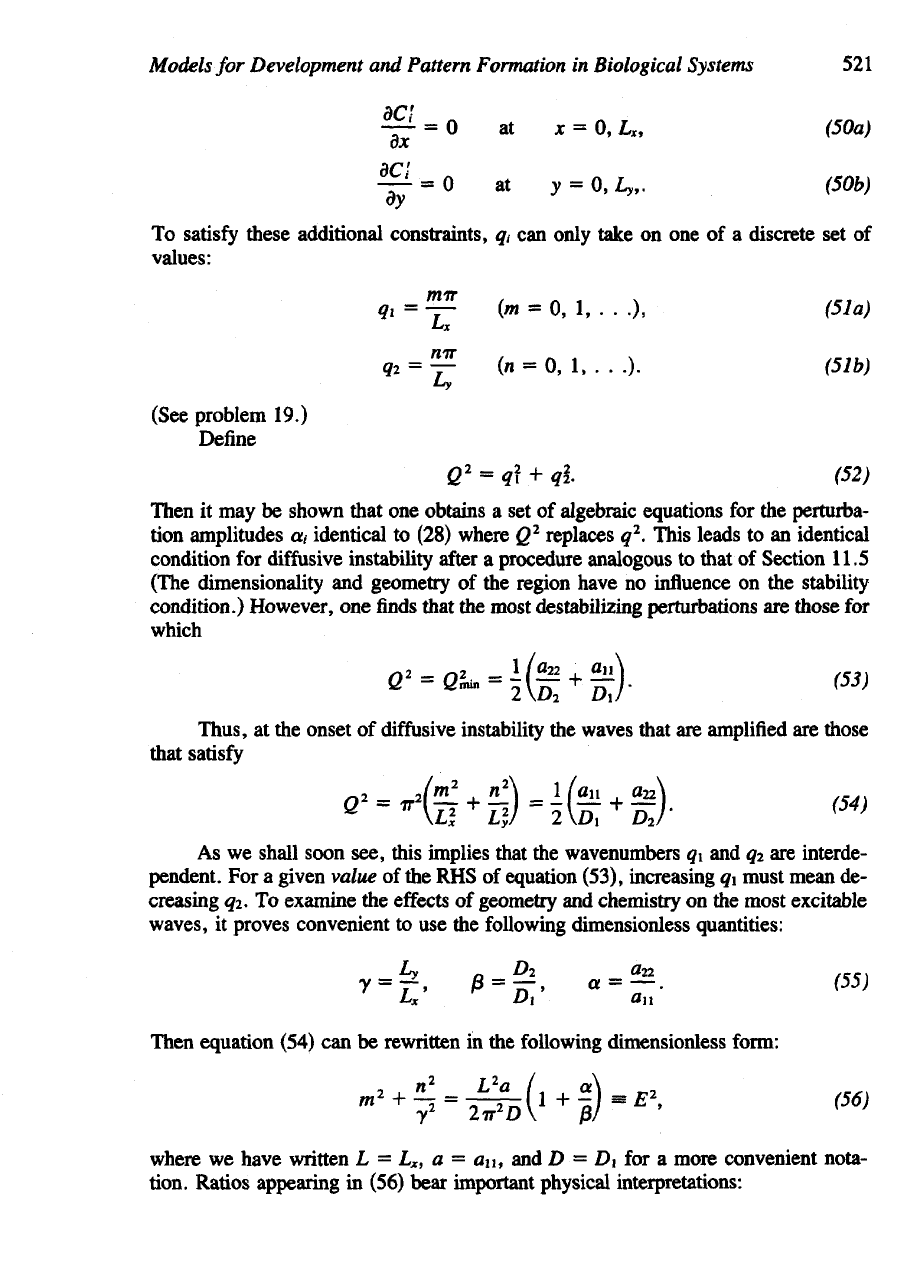
Models
for
Development
and
Pattern
Formation
in
Biological
Systems
521
To
satisfy
these additional constraints,
q
f
can
only take
on one of a
discrete
set of
values:
(See problem 19.)
Define
Then
it may be
shown that
one
obtains
a set of
algebraic equations
for the
perturba-
tion amplitudes
a,
identical
to
(28) where
Q
1
replaces
q
2
.
This
leads
to an
identical
condition
for
diffusive
instability
after
a
procedure analogous
to
that
of
Section
11.5
(The
dimensionality
and
geometry
of the
region have
no
influence
on the
stability
condition.)
However,
one finds
that
the
most destabilizing perturbations
are
those
for
which
Thus,
at the
onset
of
diffusive
instability
the
waves that
are
amplified
are
those
that
satisfy
As
we
shall soon see, this implies that
the
wavenumbers
q\ and q^ are
interde-
pendent.
For a
given value
of the RHS of
equation (53), increasing
q\
must mean
de-
creasing
q-i.
To
examine
the
effects
of
geometry
and
chemistry
on the
most excitable
waves,
it
proves convenient
to use the
following dimensionless quantities:
T
equation (54)
can be
rewritten
in the
following dimensionless
form:
where
we
have written
L = L
x
, a =
a\\,
and D = D\ for a
more convenient nota-
tion. Ratios appearing
in
(56) bear important physical interpretations

522
Spatially
Distributed Systems
and
Partial
Differential
Equation
Models
Thus
the
quantity
E
2
,
defined
by the RHS of
equation (56), stands
for
Note that,
by
(54),
E
2
=
Q
2
L
2
/ir
2
.
In
the
following example
of
parameter variations
it
will
be
assumed that
a and
/3
[and
e
appearing
in
(39)]
are
held
fixed so
that condition (39)
is
just satisfied. Thus
we
consider
a
system
at the
onset
of
diffusive
instability when
only
the
modes satis-
fying
(54)
or
alternatively (56) lead
to the
formation
of
patterns. From equation (56)
it
can be
seen that
the
value
of E
2
can be
changed even though
a and /3
might
be
held
constant.
For
example, this
can be
done
by
1.
Increasing
the
diffusion
rates
D\ and D
2
of
both chemicals
but
keeping
ft =
D
2
/D,
fixed.
2.
Altering
all the
chemical reaction rates
ay
while keeping
a =
a
2
2/a\\
and
e =
012021
A*n
fixed.
3.
Increasing
or
decreasing
the
domain size
L.
The
effect
of any
such parameter variation
is
that
the
relative ratios
of the do-
main
size
and the
chemical range size will change.
As
such changes occur,
the
value
of
E
2
changes.
One
then
expects
abrupt transitions
in the
values
of and n
that sat-
isfy
(56).
In
the
following example
we
take
y = 2 for
illustrative purposes.
We
compute
the
expression
and
then rank
the
pairs
of
integers
(m, n) in
order
of
increasing values
of E
2
(see
Figure 11.5).
The
succession
of
modes thus generated might arise
from
any one of
the
above parameter variations
(as
long
as E
2
is
thereby made
to
vary gradually
and
monotonically).
A
different value
of y
would lead
to a
somewhat
different
sequence
of
modes. Some
of the
chemical
patterns
corresponding
to
such modes
are
then dis-
played schematically
in
Figure 11.6.
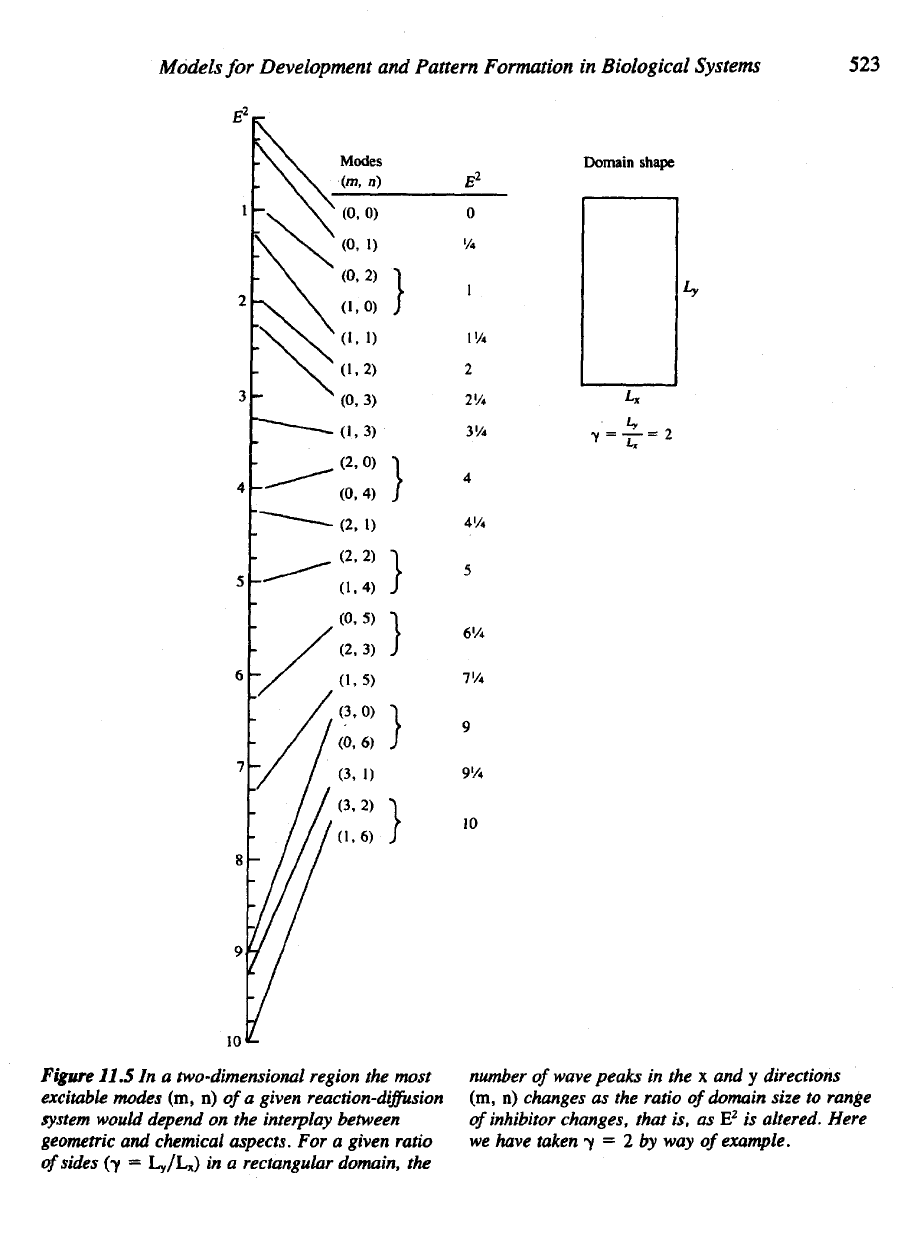
Models
for
Development
and
Pattern Formation
in
Biological Systems
523
Figure
11.5
In a
two-dimensional region
the
most
excitable
modes
(m, n)
of
a
given
reaction-diffusion
system
would depend
on the
interplay between
geometric
and
chemical aspects.
For a
given ratio
of
sides
(-y =
Ly/L
x
)
in a
rectangular domain,
the
number
of
wave
peaks
in the x and y
directions
(m, n)
changes
as the
ratio
of
domain size
to
range
of
inhibitor
changes,
that
is, as E
2
is
altered. Here
we
have taken
y = 2 by way
of
example.

524
Spatially
Distributed Systems
and
Partial
Differential
Equation Models
Figure
11.6
The first
several modes
(m, n) in the
sequence
predicted
in
Figure 11.5.
(b = d) The
functional
shapes
of
the
excitable perturbations
are
shown
by
dotted outlines. Stippled areas
are
those
in
which chemical concentrations
are
higher than
their
steady-state values.
A
transition from
(a) to
(h)
(and
beyond)
would occur
if
the
size
of the
domain
was
increased
or the
size
of
the
chemical
range
was
decreased.
From such results
several
observations
can be
made:
1. The
transitions
from
one
mode
to the
next
do not
necessarily occur
at
equal
increments
of the
parameter
E
2
;
some transitions
are
closer
than others.
2.
There
are
certain
values
of the
parameter
E
2
that correspond
to
more than
one
possible
mode.
Which mode
is
actually expressed would then depend
on
initial

Models
for
Development
and
Pattern Formation
in
Biological
Systems
525
conditions
and
nonlinear interactions that might tend
to
stabilize
one
pattern
at
the
expense
of a
second.
3.
When
the
domain
is
wider
in one
direction (such
as in the
example
in
Figure
11.5
L
y
=
2L
X
), there
is a
tendency
for
successive subdivisions
to
occur
in the
longer
direction
before
they occur
in the
shorter one.
Such
results bear several interesting implications
in
developmental systems.
The first of
these
is
that
the
interactions
of
diffusing
morphogens
in a
growing
do-
main
will lead
to a
discrete
succession
of
patterns.
Kauffman
et. al.
(1978) have pro-
posed
an
intriguing application
of
such ideas
to the
sequence
of
compartmental sub-
division
in the
imaginal disks
of
Drosophila (see
box
"Chemical Patterns
and
Compartments
in
Drosophila"). Murray (1981)
has
similarly applied these concepts
to the
spatial succession
of
patterns that occur
on
animal coats
as the
geometry
of th
domain
changes (for example,
from
an
extremity
to a
broader region such
as the
body).
His
model
is
discussed
in
greater detail
in
section 11.8.
Similar
ideas
with constant domain size
and
other spatially varying parameters
have been used
in a
number
of
different contexts. Herding
et al.
(1983)
have shown,
for
example, that spiral patterns typical
of
those
found
on
sunflower
heads
can be
generated
by a
reaction-diffusion system
in a
circular domain with
diffusivities
that
vary
as r
2
,
where
r is the
radial distance. Other implications
for
pattern formation
systems
are
suggested
in the
problems
as
topics
for
independent exploration.
To
keep
the
limitations
of
this theory
in
perspective,
one
must remember that
we
have been operating under
the
admittedly artificial assumption that
the
patterns
develop
at or
close
to the
critical bifurcation (that
is, at the
onset
of
diffusive
insta-
bility). When
a
whole range
of Q*
values
are
excitable,
one
must again address
the
possible
nonlinear effects that lead
to
considerably more complicated problems.
Although
linear analysis
of
two-
or
three-dimensional cases
is an
immediate
generalization
of the
one-dimensional case, there
are
genuinely novel
effects
that
arise
beyond
the
predictive
power
of
these
theories.
For
large-amplitude perturba-
tions,
nonlinear interactions
of the
waves
in the x and y
directions play
an
increas-
ingly important
role.
The final
patterns
may be
different
from
those anticipated
solely
on the
basis
of the
linear approximations.
We
summarize some
of our
findings
in the
following statements:
1.
Pattern formation
can
only occur
if the
range
of
inhibition
is
greater than
the
range
of
activation:
2. The
type
of
patterns tha hen occur depends
on two
factors:
a. y = rr = the
geometry
of the
domain,
LX
L
2
b.
-TV-
= the
ratio
of the
size
of the
domain
to the
range
of the
inhibitor.
D/a
3.
Parameter variations
can
lead
to
changes
in the
factors described
in 2
without
af-
fecting
the
inequality given
in 1 or
vice versa.
